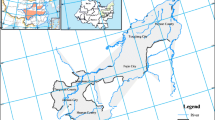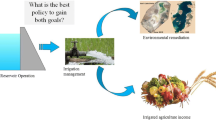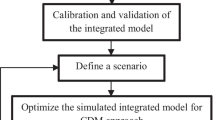Abstract
This research uses the simulation–optimization approach for the conjunctive use of surface and underground water in climate change conditions. For this purpose, Multi-Objective Invasive Weed Optimization Algorithm (MOIWOA) is developed for three benchmark functions in order to verify the algorithm and its results in the form of Pareto Front with MOPSO and NSGA-II were compared. Then, developed MOIWOA is applied for optimal water allocation to drinking-industry and agricultural needs in order to (1) maximize reliability index of water supply system, and (2) maximize resiliency index of a water supply system(from a failure period due to lack of water supply). The findings show that the model effectively reduces failure periods and allocates water resources efficiently to consumption sectors during hot months. The highest increase in reliability and resiliency indexes is observed in the RCP85 climate change scenario (as pessimistic scenario) for time period 2070–2099, with an 11% increase in reliability and a 66% increase in resiliency. In this research, Gray Relationship Analysis (GRA) is used to select the best solution from the set of Pareto solutions. Also, multi-objective solutions are prioritized and ranked based on Gray Relational Grade (GRG).







Similar content being viewed by others
Availability of Data and Materials
Some or all data, models, or code that support the findings of this study are available from the corresponding author upon reasonable request.
References
Afshar A, Zahraei A, Mariño MA (2010) Large-scale nonlinear conjunctive use optimization problem: Decomposition algorithm. J Water Resour Plan Manag 136(1):59–71. https://doi.org/10.1061/(ASCE)0733-9496(2010)136:1(59)
Ahmadianfar I, Noshdian S, Elagib NA, Salarijazi M (2021) Robust diversity-based sine-cosine algorithm for optimizing hydropower multi-reservoir systems. Water Resour Manag 35:3513–3538
An-Vo D-A, Mushtaq S, Nguyen-Ky T, Bundschuh J, Tran-Cong T, Maraseni TN, Reardon-Smith K (2015) Nonlinear optimisation using production functions to estimate economic benefit of conjunctive water use for multicrop production. Water Resour Manag 29(7):2153–2170. https://doi.org/10.1007/s11269-015-0933-y
Asgari H-R, Bozorg-Haddad O, Pazoki M, Loáiciga HA (2016) Weed optimization algorithm for optimal reservoir operation. J Irrig Drain Eng 142(2). https://doi.org/10.1061/(ASCE)IR.1943-4774.0000963
Ashofteh P-S, Bozorg-Haddad O, Akbari-Alashti H, Mariño MA (2015a) Determination of irrigation allocation policy under climate change by genetic programming. J Irrig Drain Eng 141(4). https://doi.org/10.1061/(ASCE)IR.1943-4774.0000807
Ashofteh P-S, Bozorg-Haddad O, Loáiciga HA (2015b) Evaluation of climatic-change impacts on multiobjective reservoir operation with multiobjective genetic programming. J Water Resour Plan Manag 141(11). https://doi.org/10.1061/(ASCE)WR.1943-5452.0000540
Bazargan-Lari MR, Kerachian R, Mansoori A (2009) A conflict-resolution model for the conjunctive use of surface and groundwater resources that considers water-quality issues: a case study. Environ Manag 43(3):470–482. https://doi.org/10.1007/s00267-008-9191-6
Binh TT, Korn U (1997) MOBES: A multi-objective evolution strategy for constrained optimization problems. The 3rd International Conference on Genetic Algorithms MENDEL, Brno 176–182
Bozorg-Haddad O, Tabari MMR, Fallah-Mehdipour E, Mariño MA (2013) Groundwater model calibration by meta-heuristic algorithms. Water Resour Manag 27(7):2515–2529. https://doi.org/10.1007/s11269-013-0300-9
Chang F-J, Wang Y-C, Tsai W-P (2016) Modelling intelligent water resources allocation for multi-users. Water Resour Manag 30(4):1395–1413. https://doi.org/10.1007/s11269-016-1229-6
Chen J, Yu C, Cai M, Wang H, Zhou P (2020) Multi-objective optimal allocation of urban water resources while considering conflict resolution based on the PSO algorithm: A case study of Kunming, China. Sustainability 12(4):1337. https://doi.org/10.3390/su12041337
Datta S, Bandyopadhyay A, Pal PK (2008) Slag recycling in submerged arc welding and its influence on weld quality leading to parametric optimization. Int J Adv Manuf Technol 39(3–4):229–238. https://doi.org/10.1007/s00170-007-1224-4
Donyaii A, Sarraf A, Ahmadi H (2020) Water reservoir multiobjective optimal operation using Grey Wolf optimizer. Shock Vib 3:1–10. https://doi.org/10.1155/2020/8870464
Fallah-Mehdipour E, Bozorg-Haddad O, Mariño MA (2013) Prediction and simulation of monthly groundwater levels by genetic programming. J Hydro-Environ Res 7(4):253–260. https://doi.org/10.1016/j.jher.2013.03.005
Fonseca CM, Fleming PJ (1995) An overview of evolutionary algorithms in multiobjective optimization. Evol Comput 3(1):1–16. https://doi.org/10.1162/evco.1995.3.1.1
Ghosh S, Kashyap D (2012) Kernel function model for planning of agricultural groundwater development. J Water Resour Plan Manag 138(3). https://doi.org/10.1061/(ASCE)WR.1943-5452.0000178
Haq AN, Marimuthu P, Jeyapaul R (2008) Multi response optimization of machining parameters of drilling Al/SiC metal matrix composite using grey relational analysis in the Taguchi method. Int J Adv Manuf Technol 37(3–4):250–255. https://doi.org/10.1007/s00170-007-0981-4
Hashimoto T, Stedinger JR, Loucks DP (1982) Reliability, resiliency, and vulnerability criteria for water resource system performance evaluation. Water Resour Res 18(1):14–20. https://doi.org/10.1029/WR018i001p00014
Heydari F, Saghafian B, Delavar M (2016) Coupled quantity-quality simulation-optimization model for conjunctive surface-groundwater use. Water Resour Manag 30(12):4381–4397. https://doi.org/10.1007/s11269-016-1426-3
IPCC-TGCIA (1999) Guidelines on the use of scenario data for climate impact and adaptation assessment. eds. Carter, T.R., Hulme, M. and Lal, M., Version 1, 69pp. Intergovernmental Panel on Climate Change, Task Group on Scenarios for Climate Impact Assessment
IPCC (2007) Summary for Policymakers. In: Climate Chang 2007: The Physical Science Basis. Contribution of Working Group I to the Fourth Assessment Report of the Intergovernmental Panel on Climate Change, Cambridge University Press, Cambridge, United Kingdom and New York, USA, pp 18
Jahandideh-Tehrani M, Bozorg-Haddad O, Loáiciga HA (2020) Application of particle swarm optimization to water management: An introduction and overview. Environ Monit Assess 192(5):1–18. https://doi.org/10.1007/s10661-020-8228-z
Jakeman AJ, Hornberger GM (1993) How much complexity is warranted in a rainfall-runoff model? Water Resour Res 29(8):2637–2649. https://doi.org/10.1029/93WR00877
Jones PD, Hulme M (1996) Calculating regional climatic time series for temperature and precipitation: Methods and illustrations. Int J Climatol 16(4):361–377. https://doi.org/10.1002/(SICI)1097-0088(199604)16:4%3c361::AID-JOC53%3e3.0.CO;2-F
Kalhori M, Ashofteh P-S, Moghadam SH, Singh VP (2022) Investigating the effect of uncertainty of AOGCM-TAR and AOGCM-AR5 climate change models on river runoff. Arab J Geosci 15. https://doi.org/10.1007/s12517-022-10471-1
Karamouz M, Rezapour Tabari MM, Kerachian R (2007) Application of genetic algorithms and artificial neural networks in conjunctive use of surface and groundwater resources. Water Int 32(1):163–176. https://doi.org/10.1080/02508060708691973
Khozeymehnezhad H, Nazeri Tahroudi M (2019) Annual and seasonal distribution pattern of rainfall in Iran and neighboring regions. Arab J Geosci 12:271. https://doi.org/10.1007/s12517-019-4442-9
Klemeš V, Srikanthan R, McMahon TA (1981) Long-memory flow models in reservoir analysis: What is their practical value? Water Resour Res 17(3):737–751. https://doi.org/10.1029/WR017i003p00737
Kousali M, Salarijazi M, Ghorbani Kh (2022) Estimation of non-stationary behavior in annual and seasonal surface freshwater volume discharged into the Gorgan Bay, Iran. Nat Resour Res 31:835–847
Lalehzari R, Boroomand Nasab S, Moazed H, Haghighi A (2016) Multiobjective management of water allocation to sustainable irrigation planning and optimal cropping pattern. J Irrig Drain Eng 142(1). https://doi.org/10.1061/(ASCE)IR.1943-4774.0000933
Li P, Qian H, Wu J (2018) Conjunctive use of groundwater and surface water to reduce soil salinization in the Yinchuan Plain, North-West China. Int J Water Resour Dev 34(3):337–353. https://doi.org/10.1080/07900627.2018.1443059
Mansouri Daneshvar MR, Ebrahimi M, Nejadsoleymani H (2019) An overview of climate change in Iran: Facts and statistics. Environ Syst Res 8(7). https://doi.org/10.1186/s40068-019-0135-3
Mehrabian AR, Lucas C (2006) A novel numerical optimization algorithm inspired from weed colonization. Eco Inform 1(4):355–366. https://doi.org/10.1016/j.ecoinf.2006.07.003
Mitchell TD (2003) Pattern scaling: An examination of the accuracy of the technique for describing tuture climates. Clim Change 60(3):217–242
Mohammad-Azari S, Bozorg-Haddad O, Loáiciga HA (2020) State-of-art of genetic programming applications in water-resources systems analysis. Environ Monit Assess 192(2):1–17. https://doi.org/10.1007/s10661-019-8040-9
Mohan S, Jothiprakash V (2003) Development of priority-based policies for conjunctive use of surface and groundwater. Water Int 28(2):254–267. https://doi.org/10.1080/02508060308691691
Naghdi S, Bozorg-Haddad O, Khorsandi M, Chu X (2021) Multi-objective optimization for allocation of surface water and groundwater resources. Sci Total Environ 776(12). https://doi.org/10.1016/j.scitotenv.2021.146026
Narayan Sethi L, Panda SN, Nayak MK (2006) Optimal crop planning and water resources allocation in a coastal groundwater basin, Orissa, India. Agric Water Manag 83(3):209–220. https://doi.org/10.1016/j.agwat.2005.11.009
Nikam NG, Regulwar DG (2015) Optimal operation of multipurpose reservoir for irrigation planning with conjunctive use of surface and groundwater. J Water Resour Prot 7(8):636–646. https://doi.org/10.4236/jwarp.2015.78052
Panda A, Sahoo AK, Rout AK (2016) Multi-attribute decision making parametric optimization and modeling in hard turning using ceramic insert through grey relational analysis: A case study. Decis Sci Lett 5(4):581–592. https://doi.org/10.5267/j.dsl.2016.3.001
Rasco P, Szeidl L, Semenov MA (1991) A serial approach to local stochastic models. Ecol Model 57(1–2):27–41. https://doi.org/10.1016/0304-3800(91)90053-4
Safavi HR, Darzi F, Mariño MA (2010) Simulation-optimization modeling of conjunctive use of surface water and groundwater. Water Resour Manag 24(10):1965–1988. https://doi.org/10.1007/s11269-009-9533-z
Safavi HR, Enteshari S (2016) Conjunctive use of surface and ground water resources using the antsystem optimization. Agric Water Manag 173:23–34. https://doi.org/10.1016/j.agwat.2016.05.001
Sahoo AK, Sahoo B (2013) Performance studies of multilayer hard surface coatings (TiN/TiCN/Al2O3/TiN) of indexable carbide inserts in hard machining: Part-II (RSM, grey relational and techno economical approach). Measurement 46(8):2868–2884. https://doi.org/10.1016/j.measurement.2012.09.023
Schaffer JD (1985) Multiple objective optimizations with vector evaluated genetic algorithms. The 1st International Conference on Genetic Algorithms, Pittsburgh, PA, USA, July
Singh A, Panda SN, Saxena CK, Verma CL, Uzokwe VNE, Krause P, Gupta SK (2016) Optimization modeling for conjunctive use planning of surface water and groundwater for irrigation. J Irrig Drain Eng 142(3). https://doi.org/10.1061/(ASCE)IR.1943-4774.0000977
Tarebari H, Javid AH, Mirbagheri SA, Fahmi H (2018) Multi-objective surface water resource management considering conflict resolution and utility function optimization. Water Resour Manag 32(14):4487–4509. https://doi.org/10.1007/s11269-018-2051-0
Tosun N, Pihtili H (2010) Gray relational analysis of performance characteristics in MQL milling of 7075 Al alloy. Int J Adv Manuf Technol 46:509–515. https://doi.org/10.1007/s00170-009-2118-4
Van Vuuren DP, Edmonds J, Kainuma M, Riahi K, Thomson A, Hibbard K, Hurtt GC, Kram T, Krey V, Lamarque J-F, Masui T, Meinshausen M, Nakicenovic N, Smith SJ, Rose SK (2011) The representative concentration pathways: An overview. Clim Change 109:5–31. https://doi.org/10.1007/s10584-011-0148-z
Wilby RL, Harris I (2006) A framework for assessing uncertainties in climate change impacts: low flow scenarios for the River Thames, UK. Water Resour Res 42(2):1–10
Zhang J, Dong Z, Chen T (2020) Multi-objective optimal allocation of water resources based on the NSGA-2 algorithm while considering intergenerational equity: A case study of the middle and upper reaches of Huaihe River Basin, China. Int J Environ Res Public Health 17(24):9289. https://doi.org/10.3390/ijerph17249289
Zhu F, Zhong P-A, Cao Q, Chen J, Sun Y, Fu J (2019) A stochastic multi-criteria decision-making framework for robust water resources management under uncertainty. J Hydrol 576:287–298
Author information
Authors and Affiliations
Contributions
Mahdieh Kalhori developed the theory and performed the computations. Seyedeh Hadis Moghadam verified the analytical methods. Parisa-Sadat Ashofteh and Seyedeh Hadis Moghadam encouraged Mahdieh Kalhori to investigate a specific aspect. Parisa-Sadat Ashofteh supervised the findings of this work, and Seyedeh Hadis Moghadam. All authors discussed the results and contributed to the final manuscript. Parisa-Sadat Ashofteh wrote the manuscript. Parisa-Sadat Ashofteh conceived the original idea.
Corresponding author
Ethics declarations
Ethical Approval
The paper is not currently being considered for publication elsewhere. All authors have been personally and actively involved in substantial work leading to the paper, and will take public responsibility for its content.
Consent to Participate
Informed consent was obtained from all individual participants included in the study.
Consent to Publish
The participant has consented to the submission of the case report to the journal.
Conflict Interests
None.
Additional information
Publisher's Note
Springer Nature remains neutral with regard to jurisdictional claims in published maps and institutional affiliations.
Supplementary Information
Below is the link to the electronic supplementary material.
Rights and permissions
Springer Nature or its licensor (e.g. a society or other partner) holds exclusive rights to this article under a publishing agreement with the author(s) or other rightsholder(s); author self-archiving of the accepted manuscript version of this article is solely governed by the terms of such publishing agreement and applicable law.
About this article
Cite this article
Kalhori, M., Ashofteh, PS. & Moghadam, S.H. Development of the Multi-Objective Invasive Weed Optimization Algorithm in the Integrated Water Resources Allocation Problem. Water Resour Manage 37, 4433–4458 (2023). https://doi.org/10.1007/s11269-023-03564-3
Received:
Accepted:
Published:
Issue Date:
DOI: https://doi.org/10.1007/s11269-023-03564-3




